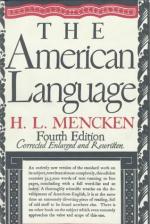
|
| Name: _________________________ | Period: ___________________ |
This test consists of 5 multiple choice questions, 5 short answer questions, and 10 short essay questions.
Multiple Choice Questions
1. Which of the following groups of foreign immigrants does Mencken not attribute influence over American English in Chapter 6.4?
(a) Russian Jews.
(b) South-Pacific Asian Islanders.
(c) Slavic peoples.
(d) Italians.
2. Which Founding Father is said to have sought to establish a new American alphabet?
(a) John Hancock.
(b) Thomas Jefferson.
(c) Benjamin Franklin.
(d) George Washington.
3. What is the physical basis to which the nasal twang of Americans is ascribed?
(a) The dry climate.
(b) Genetic diversity.
(c) Colder air.
(d) The moist climate.
4. According to Mencken, which title is subject to the greatest divergence in usage?
(a) The Honorable.
(b) Professor.
(c) General.
(d) Doctor.
5. What is the English meaning of the phrase "to carry on"?
(a) To talk endlessly.
(b) To raise hell.
(c) To shoulder one's pack.
(d) To be on the job.
Short Answer Questions
1. Who "tries" a legal case in England?
2. What does Sayce say that language is composed of in 1879?
3. Mencken claims that Noah Webster contains less of the scientific inquirer and more of what?
4. According to Benjamin Franklin, what was roughly the population of the colonies in 1751?
5. Who protested the adoption of the broad "a" in an 1857 work entitled "The Autocrat at the Breakfast Table"?
Short Essay Questions
1. How does Mencken characterize Shakespeare and what is the Bard's relevance on American English?
2. In Chapter 1.2, whom does Mencken identify as chiefly responsible for the inhibiting of an American dialect?
3. Under what situation does language undergo great changes and renew its vitality, according to Mencken in Chapter 9.1?
4. What typically causes the difficulties of the American when hearing the Englishman or vice versa, as explained in Chapter 7.1?
5. What is revealed by the attitudes of the English conservatives in Australia towards American spelling?
6. What is Mencken's evident attitude towards the vulgar American pronunciation of foreign loan-words?
7. What characterizes the American attitude towards creating new names?
8. Upon what does Mencken claim the art of American prose is based, in Chapter 9.2?
9. With what sort of distinctions is Chapter 7.2 principally concerned?
10. What does Mencken intimate by the assertion that the "inner spirit of English" has inclined steadily towards saying "I have go" for a thousand years?
|
This section contains 790 words (approx. 3 pages at 300 words per page) |

|




